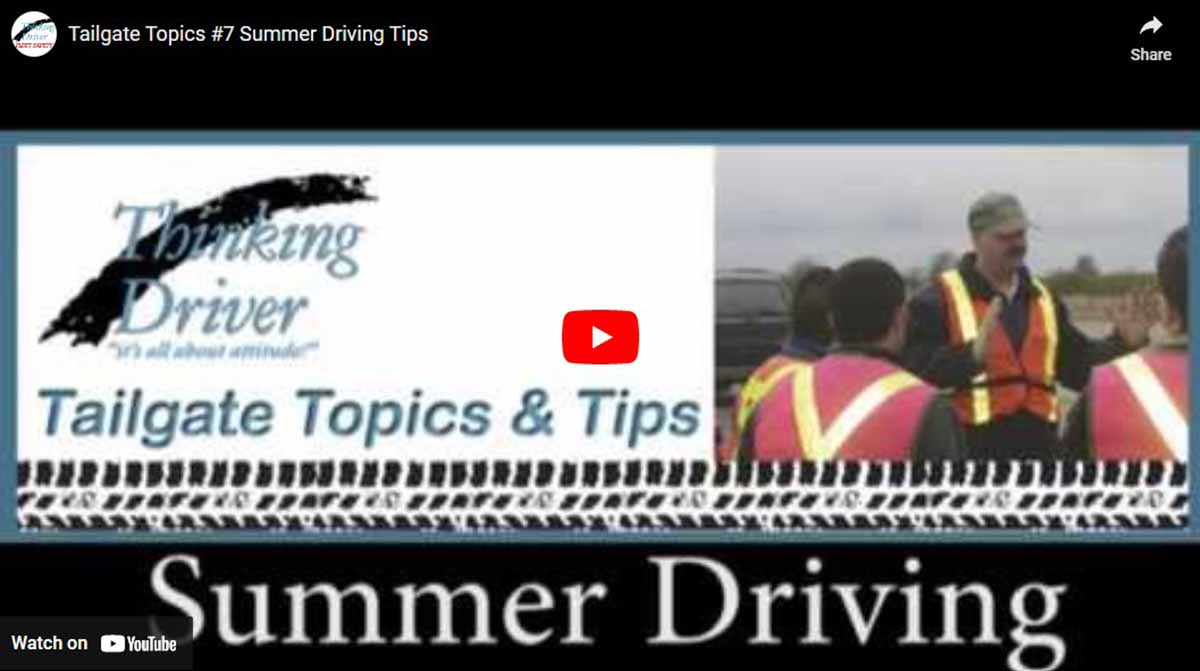Safety Meeting Planner & Agenda
Summertime Driving Challenges!
Meeting Leader:
- Prepare in advance to make this meeting effective.
- Print and read over this entire agenda.
- Think about how you want to lead the meeting.
- Is there anything that is specific to your company or operation that you can include to personalize the information?
- Review the video for this session.
- Save the link to the video in your ‘Favourites’ folder on your browser for easy access.
- Open and then minimize the viewer just before the meeting to make the video introduction smooth.
Start Your Meeting!
Opening Statement:
Summer is finally here!
The kids are out of school, families begin to plan and leave on vacations and a whole new list of challenges presents itself to drivers.
Questions for this Meeting:
Q: What challenges does summertime driving present on and off the job?
Some answers can be:
- Kids are out of school and can be anywhere…they are excited to be out in the sunshine playing and may not take care to look both ways before entering a street.
- Many more cyclists can be expected. These include:
– those little ones just learning and wobbling around with or without training wheels; experienced cyclists touring the countryside loaded with camping gear; racers training for the next event; recreational cyclists on mountain bikes or cruiser. - Slow moving recreational vehicles driven by folks who are less than experienced in these larger vehicles;
- Tourist drivers unfamiliar with roads and possibly driving slow and lost;
- Pedestrians of every type and description;
- Tourists, if you are in an area where there are attractions, campgrounds or resorts;
- Sightseers around downtown landmarks or parks;
- Folks out for a cool evening stroll;
- Summertime can create challenges for vehicles also. So if you are a trip planning, plan to have your vehicle checked.
- Excessive heat can affect drivers in negative ways.
- Can you think of more?
Q: What effect do the challenges from the last question have on the driver?
- Disucss
Q: What are the best ways to manage these challenges?
- Discuss
Tailgate Tips:
The first thing that a Thinking Driver does is plan for the unexpected. Keep these challenges in mind and expect them so that you are not surprised.
Children:
Anywhere that there may be children around, slow down and take extra care to think and look ahead.
Anticipate where children may be coming from and cover your brake if you are in doubt at all about where they may move to.
Remember, we all teach our kids to be safe around traffic, but some learn faster than others!
Cyclists:
Dealing with cyclists can be frustrating, particularly if they are slow and in your lane where you don’t have room to pass.
Every cyclist has different skill levels and capabilities and a different attitude towards traffic. When you encounter a cyclist on the road, remember to SHARE THE ROAD responsibly. They are not permitted to ride on the sidewalks and gravel shoulders are difficult and dangerous for most road bikes; they are required to be on the roadway and its everyone’s responsibility to share.
Take a breath, be patient and wait until you can pass safely. NEVER crowd a cyclist as you pass.
Recreational Vehicles:
You may be in a hurry to get your destination, but RVers are on a holiday! They may be less concerned about time and speed.
The driver may not be experienced in this size vehicle. Watch out particularly for rental RVs, often these drivers have no experience at all!
If you are driving in mountainous areas, you may find that many RVs are underpowered, overloaded and SLOW! Be patient with these drivers as they are likely going uphill as fast as they can!
If you are the RVer, take every opportunity to pull over if you are holding up traffic and let others by. This is much safer than waiting for the guy behind you to attempt an unsafe pass.
Tourists:
Maintaining patience behind a lost tourist is challenging but it’s only option. Give them a break and time to figure out what they are doing.
When you are travelling, check your maps first and use a GPS. Pull over if you are lost or uncertain to re-orient yourself. Avoid last minute turns or lane changes. It’s safer to go around the block or come back if you miss a turn.
Don’t ruin your vacation with an accident!
Pedestrians:
Pay particular attention in summer for pedestrians.
Scan intersections and make sure that you shoulder check before turning. In heavily trafficked tourist areas, keep your speed very low. Be aware that around lakes, beaches and parks, some of the pedestrians may have been drinking and take chances.
Vehicle Preparation:
Check your vehicle to make sure that it’s ready for summer driving.
One of the most common failures is the cooling system. Check your coolant levels regularly and top up when needed.
If you are towing a trailer, make sure that your vehicle is rated to tow the weight and has the capability to slow and stop it on the downgrades.
Make sure that you secure camping or recreational equipment in the vehicle so that it doesn’t move around or obstruct vision.
Impairment:
Summer is the time for socializing, beach parties, camping, boating, ball games and BBQs. Any one of these can involve drinking. Watch out in these areas for drivers who may be impaired and for sure DON’T DRINK & DRIVE!
Prepare for the heat!:
When overheated, our tolerance for stress goes down and we may anger more easily than normal. Recognize this and keep cool by using the vehicle air conditioning, drinking lots of fluids and taking regular breaks.
By caring for your body in the heat of summer, you will enjoy the drive more and make better, safer decisions.
Introduce the Video:
Spencer McDonald discusses ways to reduce risk while driving in summer.
Practical Challenge:
Take the group out and check the fluid levels on vehicles: coolant and washer fluid. Top up if necessary.









